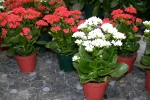Description:
Kalanchoe blossfeldiana is a very common houseplants in Europe. It is a small, succulent plant, with dark green leaves and red, yellow, orange, pink and white flowers. Blossoms are small, hollow and look like stars.

Cultivation and care:
Kalanchoe is a plant easy to cultivate; it needs high temperatures and minimal care. These indoor plants can be grown as houseplants, as well as garden plants, as long as these are planted in the garden, but in the pots. The ideal temperature at which they grow and bloom is located between 12 and 30C.
Kalanchoe is very sensitive to cold – if it is exposed only a few hours at temperatures close to 0C, the plant will die. This plant loves to sit alone in a small pot. However, the bigger the pot, the leaves will be higher. You should avoid planting in the same pot with other ornamental kalanchoe plants. Even so, transplanting flowers each spring and adding fresh soil is highly recommended.
Kalanchoe grows relatively hard, reaching an average of 15-45 cm in older plants, until stems become woody. Roots are very sensitive and there are recommended to plant the kalanchoes in ceramic pots, allowing better root aeration. Another trick you could use is placing the bottom layer of pebbles pots to ensure good drainage and using the compost only slightly, with plenty of peat and sand; always remove excess water that gathers in the tray and do not let the pot sit in water.
The Kalanchoe plant needs more light to grow, and if it does not get enough light, the leaves will turn red in the margins. During the summer, it should not be placed in full sun for its leaves, which contain much water because it will burn. In early spring and autumn, direct sunlight is weak enough not to hurt the plant.
Another hint is to well water the plants when the soil is dry, but be careful not to overdo it, because it can rot the roots. Water should be soaked at room temperature. The kalanchoe plant resists at a dry but not for long, because it will seriously affect the development and the plant will require an adjustment period when you return to a normal environment. This time it is best to avoid wetting the leaves.
When flowers begin to dry, cut them and allow the plant to rest, also after the break is good to reduce watering flowers, because that flower during the rest only needs little water. Soon will appear new buds and the plant will bloom again. This alternation of periods of prosperity and the rest will continue all the year, every season
Kalanchoe Blossfeldiana Pictures Gallery



